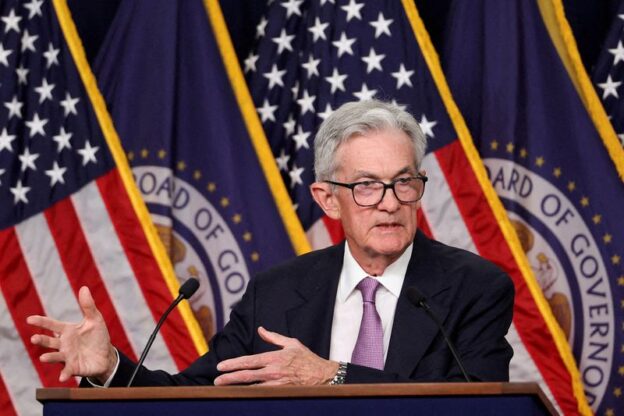By Howard Schneider
NASHVILLE, Tennessee (Reuters) -Federal Reserve Chair Jerome Powell indicated on Monday the U.S. central bank would likely stick with quarter-percentage-point interest rate cuts moving forward and was not “in a hurry” after new data boosted confidence in ongoing economic growth and consumer spending.
“This is not a committee that feels like it is in a hurry to cut rates quickly,” Powell told a National Association for Business Economics conference, even though the policy-setting Federal Open Market Committee kicked off its easing cycle with a larger-than-expected half-percentage-point reduction at its Sept. src7-src8 meeting.
“We will do what it takes in terms of the speed with which we move,” Powell said, to try to keep inflation progressing towards the Fed’s 2% target while maintaining a low unemployment rate.
But, with discussion over whether the U.S. central bank might approve another large reduction to account for the fast decline of inflation since last year, Powell said the baseline was currently for two quarter-percentage-point reductions by the end of this year, as indicated in policymakers’ updated economic projections released earlier this month.
“If the economy evolves as expected, that would be two more cuts” by year’s end, for a total reduction of half a percentage point more, he told the crowd in Nashville, Tennessee.
His comments rested heavily on confidence in continued economic growth that was buoyed by recent data revisions that raised estimates of income, spending and savings and showed gross domestic income growing faster than thought.
The revisions to government reports on GDI have removed a “downside risk to the economy and suggests spending can continue at a healthy level,” Powell said.
GDI is an alternate measure of economic growth, similar to gross domestic product, but with income rather than output as the yardstick. A gap between the two led Fed officials to worry that output might be weaker than thought, but the two converged when the estimate of GDI was increased.
The economy “is in solid shape,” Powell said.
As Powell spoke, financial markets leaned more heavily into bets that the Fed would cut rates in quarter-percentage-point increments, and now see that as the likely pace through the middle of next year.
The outcome will still hinge on incoming data, including the September U.S. employment report due to be released on Friday and the October employment report, which is due on Nov. src, just days before the central bank’s Nov. 6-7 meeting.
Stocks eased slightly after Powell’s remarks, though major indices closed higher on the day. Yields on U.S. Treasuries climbed.
‘RISKS ARE TWO-SIDED’
Powell said the U.S. economy seems poised for a continued slowdown in inflation that will let the Fed reach a more neutral level of interest rates “over time.”
“Disinflation has been broad-based, and recent data indicate further progress toward a sustained return to 2%,” he said. “We are not on any preset course. The risks are two-sided, and we will continue to make our decisions meeting by meeting.”
The Fed’s policy rate is currently set in the 4.75%-5.00% range. Economic projections released at the meeting earlier this month showed the median policymaker expectation was for the rate to decline further to the 4.25%-4.50% range by the end of this year, to the 3.25%-3.50% range by the end of 2025, and for policy easing to end in 2026 with the rate around the longer-run estimated “neutral” level of 2.9%.
Powell’s reference to “two-sided” risks points to the open debate Fed officials will have as data accumulate.
In an interview on Monday with Reuters, Atlanta Fed President Raphael Bostic, for example, said he expected an “orderly” pace of rate cuts moving forward, but was open to another half-percentage-point cut if coming employment reports show a significant weakening in job growth. Both he and Fed Governor Michelle Bowman said the fact that inflation stripped of volatile food and energy costs remained at 2.7% in August was a reason not to cut too fast.
The most recent inflation data showed a headline rate of just 2.2%.
Powell, however, said he felt that “broader economic conditions … set the table for further disinflation.”
Goods prices have been declining, while the once-sticky aspects of the service industry saw inflation now “close to its pre-pandemic pace,” Powell said.
Progress on housing inflation has been “sluggish,” the Fed chief said, but “the growth rate in rents charged to new tenants remains low. As long as that remains the case, housing services inflation will continue to decline.”
The job market remains “solid,” he said, with a 4.2% unemployment rate still a low level and around that which Fed officials consider sustainable in the long run with inflation at the central bank’s target.
“Overall, the economy is in solid shape; we intend to use our tools to keep it there,” Powell said, adding that the Fed had made “a good deal of progress” in lowering inflation without a sharp rise in joblessness.

Comments are closed